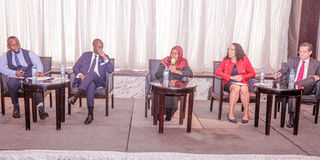Prime
Africa’s economy tested by global headwinds

Bank of Tanzania deputy governor Sauda Msemo speaks during the launch of the IMF’s Regional Economic Outlook for Sub-Saharan Africa in Dar es Salaam yesterday. Others from right are IMF Resident Representative Sebastian Acevedo, IMF Deputy Director for Africa Catherine Pattillo, Stanbic Bank Tanzania CEO Manzi Rwegasira and Mwananchi Communications Limited acting executive editor Mpoki Thomson. Story on Page 3. PHOTO | Sunday George
What you need to know:
- The recent economic recovery in Africa can be linked to successful domestic reforms, enhanced fiscal management and improved monetary policies
Dar es Salaam. Sub-Saharan Africa's hard-fought economic recovery has been overtaken by recent events, threatening to derail the region's remarkable economic gains.
According to the latest International Monetary Fund’s (IMF) Regional Economic Outlook for sub-Saharan Africa, the region’s economic growth rebounded to 4 percent in 2024, following two years of sluggish performance.
The recovery has been attributed to effective domestic reforms, stronger fiscal management, and improved monetary policies, which have enabled African economies to withstand global shocks such as rising interest rates and commodity price volatility.
However, slower global growth and renewed US tariffs have forced the IMF to revise sub-Saharan Africa’s growth forecasts downward, to 3.8 percent for 2025 and 4.2 percent for 2026.
The report, launched yesterday in Dar es Salaam, attributes the slowdown to the financial squeeze and changing economic dynamics, with African countries paying considerably higher interest rates on Eurobond issuances compared to pre-pandemic times.
Interest payments now consume around 12 percent of government revenues, squeezing fiscal space for development initiatives.
The report cites tough measures by governments as critical steps towards fiscal discipline.
Speaking at the launch event, Deputy Governor of the Bank of Tanzania, Ms Sauda Msemo, noted that while external risks remain, countries like Tanzania are taking proactive steps.
She highlighted the government's swift action to mobilise domestic resources following cuts in foreign aid, particularly from the United States, which had previously supported critical sectors like health and education.
“The government prioritised health and education in the national budget, alongside physical infrastructure. Now we are ensuring these investments are adequately staffed and equipped,” she said, underlining the sequencing strategy aimed at turning Tanzania’s demographic transition into a demographic dividend.
Ms Msemo further noted that strengthening domestic resource mobilisation and expanding financing partnerships beyond traditional donors are critical to sustaining growth.
She also stressed the importance of regional integration as a buffer against global trade disruptions.
However, the deputy governor reinforced the need for vigilance and sustained reforms to safeguard macroeconomic stability.
From the private sector’s perspective, CEO of Stanbic Bank Tanzania, Manzi Rwegasira, called for greater policy predictability and ease of doing business to attract investment.
He urged governments to structure projects, particularly public-private partnerships (PPPs), in ways that balance risks and encourage private capital flow.
Infrastructure and agri-processing sectors, he said, offer strong opportunities, especially through initiatives like special agro-industrial zones.
“Properly designed projects will attract capital,” he said, adding that investment in logistics and digital infrastructure could further diversify economies and boost competitiveness.
He also called for African countries to seize shifting global perceptions about risk and position themselves as attractive investment destinations.
On top of that, the deputy director of the IMF African Department, Catherine Pattillo, warned that while infrastructure spending has been robust, many countries have failed to secure adequate returns through tax reforms. She stressed that domestic revenue mobilisation is no longer optional but essential. “When 12 percent of your revenue goes to interest payments, it limits your ability to invest in health, education, and infrastructure,” she said.
She also urged governments to pursue better debt management strategies, including swapping costly short-term loans for longer-term, lower-interest alternatives, to ease fiscal pressure.
She further noted that with aid flows from traditional donors like the United States, Netherlands, France, and the United Kingdom declining, domestic reforms must accelerate.
However, she remained optimistic, pointing out that 11 of the 20 fastest-growing economies globally in 2025 are in Sub-Saharan Africa.
Despite global headwinds, she said, Sub-Saharan Africa’s policy agility, internal reforms, and youthful dynamism are positioning the region not merely to survive but to thrive.
Ms Pattillo captured this sentiment, noting, “The world is volatile, but Africa is demonstrating resilience. With the right policies, the continent can not only survive but thrive.”
She added that regional integration is crucial for resilience, urging African governments to prioritise cross-border trade facilitation and financial integration, particularly through the African Continental Free Trade Area (AfCFTA).
“Regional trade can partially shield African economies from global volatility,” she said.
IMF Resident Representative for Tanzania, Sebastian Acevedo, underscored the need for greater investment in human capital to harness the region’s youthful population, warning that without substantial improvements in education, healthcare, and skills development, the expected demographic dividend would be missed.
Praising Tanzania’s macroeconomic management — citing stable inflation, moderate debt risk, and a diversified economy—Mr Acevedo said the country is well-positioned to navigate both current and future challenges.




